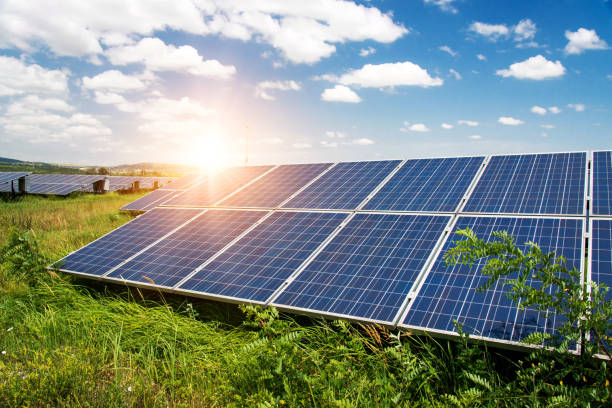A new energy project in the U.K. has ambitious plans to create “soil batteries” to store solar power underground.
The design, one of the dozens of ideas that recently received a significant funding boost from the U.K. government, leverages the Earth’s teeming microbial life to transfer energy, according to a report published by Euronews on Friday.
“The possible scale of that impact is really exciting,” lead researcher Dr. Michael Harbottle of Cardiff University told Euronews Green. “To see something that’s really quite novel, possibly having a big impact, is what’s driving us.”
Harbottle first had the thought after reading about a chemically-powered concrete battery, and he questioned whether a biological method would not have more to offer.
Researchers at Cardiff University are already using a plentiful natural resource, similar to sand and water batteries, to help solve the problem of renewable energy storage.
The subject matter of Harbottle’s research is still conceptual. But he wasn’t the first to recognize soil’s potential in this way.
There are numerous instances of people successfully conducting experiments by simply adding soil to a jar, adding a few electrodes, and connecting them, the scientist claims.
The idea is to stimulate particular microorganisms in the soil by using buried electrodes to receive electricity from solar panels.
“If you make energy available to microorganisms, they’ll use it in some way to survive,” explained Harbottle.
“Just like providing food, if you provide electrical energy, there are organisms who can use that to perform electrosynthesis, where they synthesize [combine] carbon-based molecules from carbon dioxide.”
These bugs that feed on them expel electrons that go across the circuit and produce electricity as needed—just another peculiar phase of sunlight’s 150 million-kilometer trek to Earth.
It is similar to photosynthesis, which occurs when plants take up CO2 and change it in their cells below the ground. Electricity, carbon dioxide, action: The “bugs,” as Harbottle refers to them, start using the energy to decrease the carbon dioxide and create a more complicated chemical called acetate.
He claims that this acetate functions as a chemical energy reserve and is the same type of molecule as one could find in vinegar but without the acid. When necessary, a separate circuit (known as a microbial fuel cell) is activated, causing a different group of bacteria to become active and begin breaking down the acetate.
Although acetate is not harmful, may an excessive amount of the substance harm other life forms in this diverse ecosystem? Harbottle admits that it could. Though the deeper, wetter soil underneath the busiest top layers is where the experts focus their attention, the impact needs further investigation.
According to Harbottle, “One advantage of the idea is it doesn’t require resource-limited or hazardous chemicals like lithium that are used in other battery technologies.”
“It creates organic molecules that are often present in the soil anyway, that are produced naturally by microorganisms in smaller quantities.”
According to the project, the prototype will function every day, storing solar energy for use at night, unlike some long-term energy systems.
These batteries might eventually be positioned below solar panel fields. However, because microbial fuel cells can currently only produce modest voltages, its application in relatively low-power projects seems more immediate.
The researchers, a cross-disciplinary group of electrical and geo-environmental engineers, eventually hope to scale up by connecting hundreds of cells to create a much higher voltage.
A non-departmental public body of the government called U.K. Research and Innovation, which oversees funding for research and innovation, has invested £15 million (€16.9 million) in the emerging technology along with 67 other projects that it acknowledges are “high risk” but could have a “transformative impact.”
Earth change goes beyond melting icecaps and rising sea levels. Earth is made up of smaller interconnected systems with relatively unusual changes too.
-
FeaturesNews
IEA Predicts that Annual added Photovoltaic Capacity will be more than Quadruple to 650 GW in 2030.
Solar accounted for more than 3% of global electricity generation in 2021, according to the International Energy Agency (IEA). Annual capacity addition reached …
-
Heliene, a Canadian solar panel manufacturer, officially unveiled its new solar panel assembly lines to the public this week in Iron Mountain, Minnesota. …
-
FeaturesNews
Silicon Ranch places additional 700 MW orders for First Solar modules Under Master Supply Deal
October 21 – US solar developer Silicon Ranch has increased a 4-GW master supply agreement with First Solar Inc (NASDAQ:FSLR), securing an additional …
-
Energy EfficiencyFeaturesNews
A U.S. research team Reveals that Temperature of Solar Modules can be Reduced
A U.S. research team has found that increasing the spacing between rows of solar panels improves a PV system’s efficiency and economics by …
-
Introduction Agricultural innovation and sophisticated equipment have been in trend for some time now, motivating farmers to use more efficient methods that aren’t …
-
FeaturesNews
The 2022 All On/NCIC Incubation Program will showcase 18 of its top finalists at Demo Day.
At a Demo Day event, 18 clean energy entrepreneurs will pitch their business ideas to an audience. These entrepreneurs have successfully completed a …
-
Solinteg has just released new non-grid inverters specifically for residential applications. “Our Integ O Series inverter has a small size of 291 mm …
-
Tesla announced that it delivered a record number of solar and batteries in Q3 2022. Tesla reported that energy storage deployments increased by …
-
The recent inclusion of the storage investment tax credit (ITC) in the IRA has sparked a 21st century gold rush as individuals, businesses …
-
FeaturesNews
A new invention for rooftop wind energy claims to provide 50% more energy than solar power at the same cost.
Aeromine Technologies has patented a new bladeless wind energy unit in order to compete with the challenge of rooftop solar as a local …


